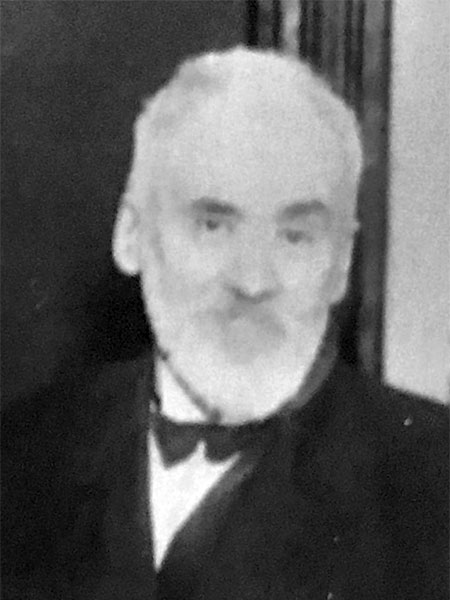 |
Joseph-Abraham Guay
|
Farmer, liveryman, land developer.
Born at St-Gervais-de-Bellechasse, Québec on 15 September 1849, the fifth of seven children of Joseph Guay and Julie Dubord, he came to western Canada in 1869 at the encouragement of Archbishop Taché and Father Ritchot, working hard to be allotted farm land in St. Boniface / St. Vital area. He established a livery stable and dairy farm at the fork of St. Mary’s and St. Anne’s roads, and built his family home at 5 St. Anne’s Road between the Red and Seine rivers. Guay owned from what is now Morier Avenue north to Carrière Avenue and eventually, acquired all the property from St. Anne’s Road to the Seine River from Clonard Avenue north to Carrière.
On 28 February 1876, he married Esther Beaugrand-dit-Champagne (1854-1927), Métisse daughter of Émmanuel Beaugrand-dit-Champagne Sr and half-sister of Émmanuel Beaugrand-dit-Champagne Jr, both supporters of Louis Riel. Her family was well respected, being successful land and horse owners in the Red River Settlement later known as St. Boniface. Abraham and Esther had 11 children. The two eldest daughters Julie Guay (1878-1918) and Emma Guay (1881-1950) devoted their lives to charity as Grey Nuns serving in local hospitals and schools. Their eldest son Jules Guay (1880-1951) drove a team of horses for the Public Works Department, Philippe Guay (1889-1957, father of Joseph-Philippe Guay) was a St. Vital alderman from 1917 to 1920 and Adélard Guay (1896-?), their youngest son, was one of the earliest St. Vital firefighters. A deeply religious man, Guay attended church regularly and was always in close contact with local clerics. Monseigneur Jubinville appeared in the couple’s 50th anniversary photo, blessing the event at Cathédrale St Boniface in February 1927.
Guay had a strong Métis connection through his wife, extended family, and community. He supported the Métis cause for rights and land ownership during the Riel rebellions, was a close friend of Louis Riel, and was a founding member of l’Union nationale métisse Saint-Joseph. It is rumoured that Guay loaned a horse called Toufant to Riel to help him make his first escape to the United States. As the story goes, when Riel asked Guay how he could return the horse, he was told to slap him on the rump as a signal to return home. Following Riel’s execution in November 1885, members of the Riel family selected some of his poems, giving them to Guay for publication as Poesies religieuses et politiques (1886), fulfilling an act of respect for Riel.
He died at St. Vital on 25 June 1927 and was buried with his wife in the St. Boniface Cemetery. He is commemorated by Guay Park and Guay Street in Winnipeg.
Death registrations, Manitoba Vital Statistics.
“Guay one of St Vital’s earliest movers and shakers,” Winnipeg Free Press, 21 August 2013.
Scrip affidavit for Beaugrand dit Champagne, Esther; Now wife of Abraham Guay; born: 22 January 1855, Library and Archives Canada.
This page was prepared by Georgette Poitras and Gordon Goldsborough.
Page revised: 10 September 2025
Memorable Manitobans
This is a collection of noteworthy Manitobans from the past, compiled by the Manitoba Historical Society. We acknowledge that the collection contains both reputable and disreputable people. All are worth remembering as a lesson to future generations.
Search the collection by word or phrase, name, place, occupation or other text:
Custom SearchBrowse surnames beginning with:
A | B | C | D | E | F | G | H | I | J | K | L | M | N | O | P | Q | R | S | T | U | V | W | Y | ZBrowse deaths occurring in:
1975 | 1976 | 1977 | 1978 | 1979 | 1980 | 1981 | 1982 | 1983 | 1984 | 1985 | 1986 | 1987 | 1988 | 1989 | 1990 | 1991 | 1992 | 1993 | 1994 | 1995 | 1996 | 1997 | 1998 | 1999 | 2000 | 2001 | 2002 | 2003 | 2004 | 2005 | 2006 | 2007 | 2008 | 2009 | 2010 | 2011 | 2012 | 2013 | 2014 | 2015 | 2016 | 2017 | 2018 | 2019 | 2020 | 2021 | 2022 | 2023 | 2024 | 2025
Send corrections and additions to this page
to the Memorable Manitobans Administrator at biographies@mhs.mb.caCriteria for Memorable Manitobans | Suggest a Memorable Manitoban | Firsts | Acknowledgements
Help us keep
history alive!